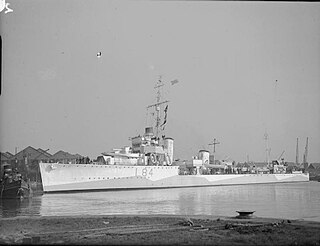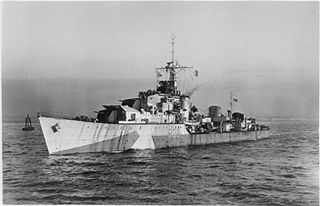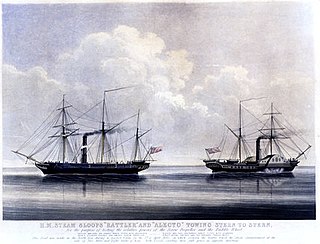
HMS Warrior is a 40-gun steam-powered armoured frigate built for the Royal Navy in 1859–1861. She was the name ship of the Warrior-class ironclads. Warrior and her sister ship HMS Black Prince were the first armour-plated, iron-hulled warships, and were built in response to France's launching in 1859 of the first ocean-going ironclad warship, the wooden-hulled Gloire. Warrior conducted a publicity tour of Great Britain in 1863 and spent her active career with the Channel Squadron. Obsolescent following the 1873 commissioning of the mastless and more capable HMS Devastation, she was placed in reserve in 1875, and was "paid off" – decommissioned – in 1883.

RFA Gold Rover(A271) was a Rover-class small fleet tanker of the Royal Fleet Auxiliary (RFA) and one of five ships that were designed by the Admiralty, all of which were built at the Swan Hunter shipyard.

HMSM33 is an M29-class monitor of the Royal Navy. Built in 1915, she saw active service in the Mediterranean during the First World War and in Russia during the Allied Intervention in 1919. She was used subsequently as a mine-laying training ship, fuelling hulk, boom defence workshop and floating office, being renamed HMS Minerva and Hulk C23 during her long life. She passed to Hampshire County Council in the 1980s and was then handed over to the National Museum of the Royal Navy in 2014. A programme of conservation was undertaken to enable her to be opened to the public. HMS M33 is located within Portsmouth Historic Dockyard and opened to visitors on 7 August 2015 following a service of dedication. She is one of only three surviving Royal Navy warships of the First World War and the only surviving Allied ship from the Gallipoli Campaign, the other being the Ottoman minelayer Nusret, preserved in Çanakkale.

HMS Cavalier is a retired C-class destroyer of the Royal Navy. She was laid down by J. Samuel White and Company at East Cowes on 28 March 1943, launched on 7 April 1944, and commissioned on 22 November 1944. She served in World War II and in various commissions in the Far East until she was decommissioned in 1972. After decommissioning she was preserved as a museum ship and currently resides at Chatham Historic Dockyard.

The Thornycroft type leader or Shakespeare class were a class of five destroyer leaders designed by John I. Thornycroft & Company and built by them at Woolston, Southampton for the Royal Navy towards the end of World War I. They were named after historical naval leaders. Only Shakespeare and Spenser were completed in time for wartime service. The other three were completed after the war, Broke and Keppel after being towed to Royal dockyards for completion, and two further ships - Saunders and Spragge - were cancelled. The function of a leader was to carry the flag staff of a destroyer flotilla, therefore they were enlarged to carry additional crew, offices and signalling equipment, allowing a fifth gun to be carried. These ships were very similar to the Admiralty type leader, but had Thornycroft design characteristics, the most noticeable being the broad, slab-sided funnels.

HMS Zest was a Z-class destroyer of the Royal Navy that saw service during World War II.

HMS Griper was a Bold-class gun-brig of the British Royal Navy, built in 1813 by Mark Williams and John Davidson at Hythe. She participated in the 1819 expedition to the Arctic led by William Parry, made a voyage to Greenland and Norway in 1823, and took part in Parry's third expedition in 1824 as a support ship. Her crew in 1819, 1823, or 1824, qualified for the "Arctic Medal", which the Admiralty issued in 1857. She was eventually broken up in 1868.

HMS Rattler was a 9-gun steam screw sloop of the Royal Navy, and one of the first British warships to be completed with screw propulsion. She was originally ordered as a paddle wheel 4-gun steam vessel from Sheerness Dockyard on 12 March 1841. She was reordered on 24 February 1842 as a propeller type 9-gun sloop from HM Royal Dockyard, Sheerness, as a new vessel. William Symonds had redesigned the ship as a screw propeller driven vessel.

HMS Token was a British submarine of the third group of the T class. She was built as P328 at Portsmouth Dockyard, and launched on 19 March 1943. So far she has been the only ship of the Royal Navy to bear the name Token.

HMS Waterloo was an 80-gun third-rate ship of the line, launched on 16 October 1818 at Portsmouth. She was designed by Henry Peake, and built by Nicholas Diddams at Portsmouth Dockyard and was the only ship built to her draught. She had originally been ordered as HMS Talavera, but was renamed on the stocks after the Battle of Waterloo.

HMS Wizard was a Conflict-class destroyer built by the White shipyard for the Royal Navy, and launched on 26 February 1895. In 1910, she was reconstructed with only two funnels. She is believed to be the only destroyer fitted with in turning screws. She was sold in 1920.

HMS Neptune was an ironclad turret ship originally designed and built in Britain for Brazil, but acquired for the Royal Navy in 1878. Modifications to suit the Royal Navy took three years to complete and the ship did not begin her first commission until 1883 with the Channel Fleet. She was transferred to the Mediterranean Fleet in 1885, but refitted in Portsmouth in 1886–87. Neptune then became the coastguard ship for the 1st Class Reserve at Holyhead until 1893 when she was placed in reserve in Portsmouth. While she was being towed to the breakers in 1903, Neptune unintentionally rammed HMS Victory, then serving as a training hulk for the Naval Signal School, collided with HMS Hero, and narrowly missed several other ships. She was scrapped in Germany in 1904.

HMS Lichfield was a 50-gun fourth-rate ship of the line of the Royal Navy, one of five such ships authorised on 16 November 1693 (three to be built in different Royal Dockyards and two to be built by commercial contract. The Lichfield was built by Master Shipwright William Stigant at Portsmouth Dockyard and launched on 4 February 1695. She was first commissioned in that year under Captain Lord Archibald Hamilton, for service in Home Waters.

The Banterer-class sailing sixth rates were a series of six 22-gun post ships built to an 1805 design by Sir William Rule, which served in the Royal Navy during the Napoleonic War. The first four were launched in 1806 and the remaining two in 1807. One ship – the Banterer – was lost in 1808 and another – the Cyane – captured by the United States Navy in 1815; the remaining four were all deleted during 1816.

The Seringapatam-class frigates, were a class of British Royal Navy 46-gun sailing frigates.

The Atholl-class corvettes were a series of fourteen Royal Navy sailing sixth-rate post ships built to an 1817 design by the Surveyors of the Navy. A further four ships ordered to this design were cancelled.

HMS Andromeda was a 32-gun Hermione-class fifth rate frigate of the Royal Navy. She was laid down in 1781 and launched in 1784. She was commissioned for the first time in 1788 when Captain Prince William Henry took command of her and sailed for the West Indies. Prince William Henry paid her off in 1789 and she was not commissioned again until 1790 in response to the Spanish Armament. In 1792 Andromeda joined the Royal Navy's Evolution Squadron in the English Channel before sailing for the Leeward Islands where she stayed until the end of 1793 when Captain Lord Northesk brought her home. She was refitted for much of 1794 before in September joining the Downs Station. Captain William Taylor assumed command in 1795, briefly sailing her to Newfoundland before returning to the North Sea Fleet in 1796. She stayed here for 3 years, seizing the 36-gun Batavian frigate Zefir in the Firth of Forth in March 1798 and participating in the Raid on Dunkirk in July 1800. After another period of service in the Leeward Islands Andromeda returned home at the Peace of Amiens and was laid up at Portsmouth Dockyard where she was broken up in September 1811.

HMCS Chebogue (K317) was a River-class frigate that served with the Royal Canadian Navy during the Second World War. She served primarily as an ocean convoy escort in the Battle of the Atlantic. She was named for Chebogue, Nova Scotia. During the war she was torpedoed and declared a constructive loss.
HMS Vesuvius was an experimental torpedo-armed warship of the British Royal Navy. Built by Pembroke Dockyard in 1873–1874, she was the first purpose-designed torpedo vessel built for the Royal Navy. Vesuvius was intended for night attacks against enemy harbours, and was armed with a single tube for Whitehead torpedoes in her bow. She was used for experimental and training purposes, and was not disposed of until 1923.

















